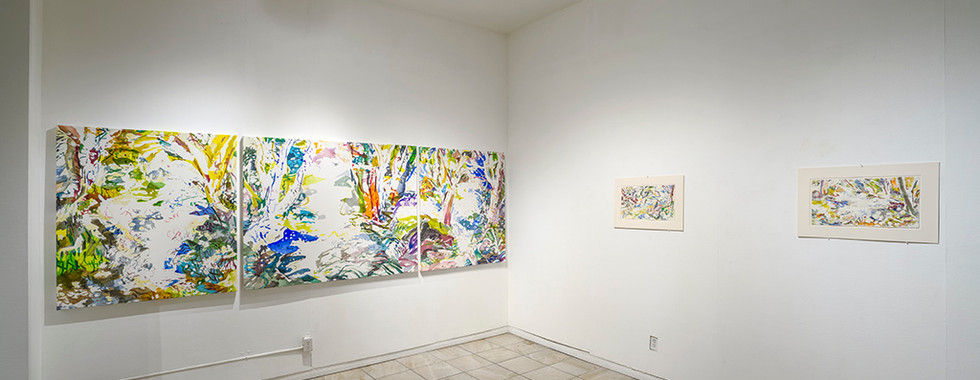Susan G. Scott - Without Shade - 22.09.22 - 16.10.22
- Cache Studio

- Nov 20, 2022
- 2 min read
Without shade
Tracing back to the traditions of Indian wisdom, Dōgen warns his disciples that what they see, feel and touch are "flowers of emptiness": behind their appearance of permanence, objects are only ephemeral crystallizations in the play of phenomena. Rather than being attached to the firm contours of objects, the concept is about letting oneself be carried by the shimmering colors that bloom in the eye and then fade away and flourish elsewhere. It is less about abandoning the sensitive world, then, than about embracing it in its variations, the awareness of its evanescence. This, perhaps, is the invitation that Susan G. Scott's latest work offers us.
In Scott's landscapes, one will not find a faithful reproduction of leaves, trees or rocks: what is presented is nature as a fabric of interactions, exchanges and flows. Deprived of the orientation of the sun, we are immersed in a nature without shade, in the heart of the rustling of the trees, the murmur of falling water, the freshness of the dew. The trees, usually pillars of the forest, become streams of clarity. With light eroding the bushes, the canvas hosts forms that are as tenuous as reflections on water.
Made on the spot, with her feet in the stream, Scott's watercolors are patiently cut and recomposed once in the studio before being enlarged on the canvas: a way of balancing the full and empty spaces as one places the silences in a poem. In the manner of the great scrolls of Chinese and Japanese painting, the landscapes are devoid of the structural power of perspective and horizon line: they unfold according to the paths that the eye traces between the colors and the marks. On this route, the white spaces dictate breath; the strokes of the brush -in their variations of thickness, textures and colors- seem to form a language, able to express the singularity of each rock, each leaf, each waterfall. Like a poem, they transmit to us the joy of observing these fleeting events that form the beauty of nature, while it is still in bloom.
-Mathilde Bois
Susan G. Scott was born in Montreal, Quebec where she now lives, teaches, and paints. She left Montreal for New York City in 1966 to study painting at Pratt Institute, the Boston Museum School, Skowhegan School of Painting and Sculpture ,and the New York Studio School of Drawing and Painting . An invitation to teach painting at Emily Carr College of Art in Vancouver brought Scott back to Canada in 1982 Scott has had many one person and group shows, including three solo exhibitions that toured Canada: Susan G. Scott: Works from 1974 to 1983, Blindman’s Buff (1988-1991) and Les Enfants Terribles (2003-2005). Her work can be found in permanent collections in Canada the USA and Europe including Art Gallery of Nova Scotia, Nickle Arts Museum, Musée d’art contemporain de Montréal, and Collection du Fonds régional d’art contemporain d’Île-de-France. Scott’s work has received support from the Canada Council, CALQ, and the 1% program for Intégrations des Arts à L’Architecture run by Quebec’s Ministry of Culture and Communications.




























































Comments